EOR: Polymer Flooding Technique History and Advancements Report
VerifiedAdded on 2023/06/08
|68
|15257
|441
Report
AI Summary
This report provides a comprehensive analysis of polymer flooding as a chemical injection technique for enhanced oil recovery (EOR). It begins by addressing the motivation for EOR due to increasing oil demand and the limitations of traditional methods. The report details the mechanism of polymer flooding, including how it improves sweep efficiency by increasing water viscosity and reducing water permeability. It discusses key parameters for successful implementation, such as polymer injection timing, screening criteria, and the importance of water quality. Alternative technologies like surfactant-polymer (SP) and alkali-surfactant-polymer (ASP) flooding, as well as gels and biopolymers like Xanthan gum, are also explored. Furthermore, the report examines polymer manufacture, characteristics like viscosity and rheology, and potential degradation factors. Finally, it covers the design and implementation of polymer flooding projects, including tracer tests, pilot injection monitoring, and numerical modeling for simulation and quality control. The report concludes by highlighting the effectiveness and challenges of polymer flooding in maximizing oil extraction from reservoirs.
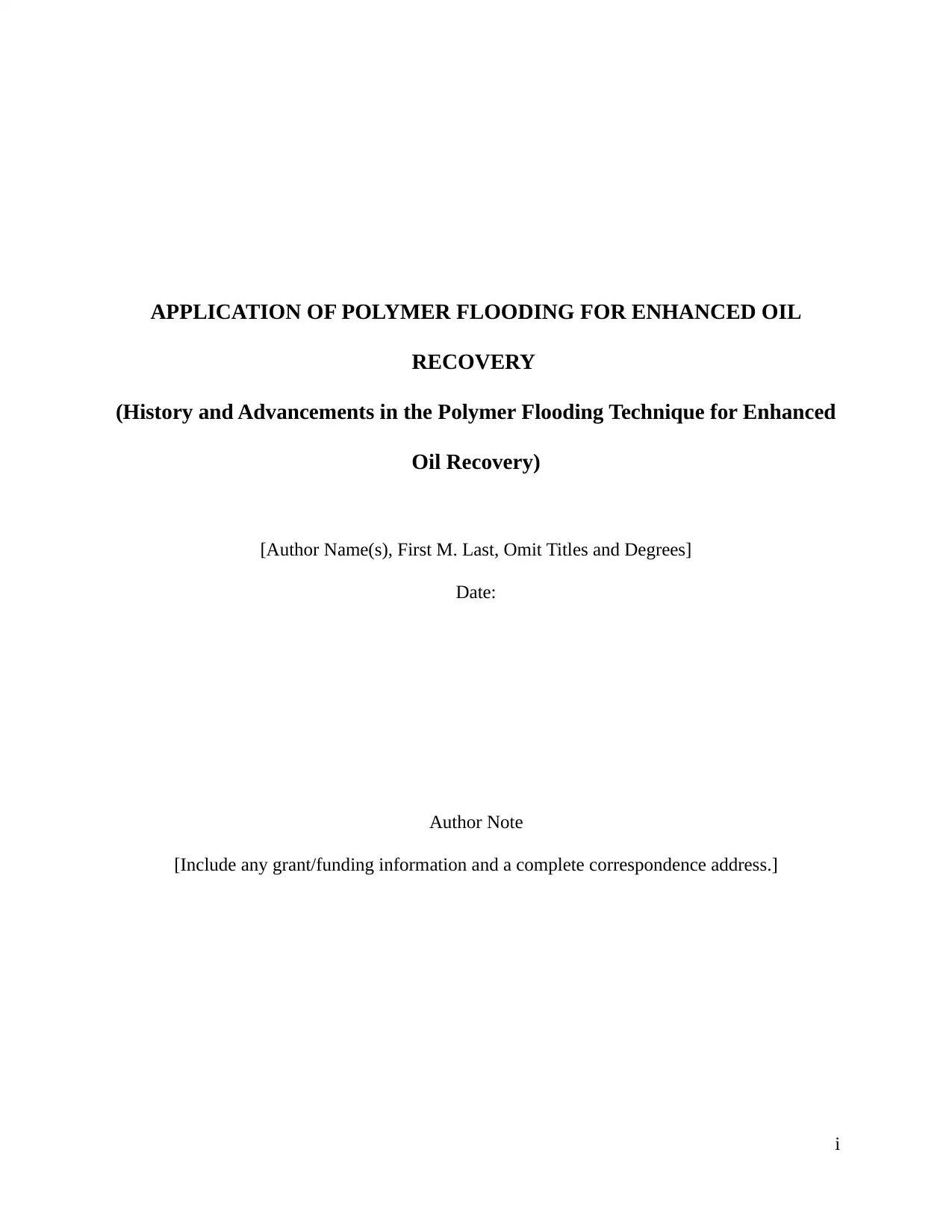
APPLICATION OF POLYMER FLOODING FOR ENHANCED OIL
RECOVERY
(History and Advancements in the Polymer Flooding Technique for Enhanced
Oil Recovery)
[Author Name(s), First M. Last, Omit Titles and Degrees]
Date:
Author Note
[Include any grant/funding information and a complete correspondence address.]
i
RECOVERY
(History and Advancements in the Polymer Flooding Technique for Enhanced
Oil Recovery)
[Author Name(s), First M. Last, Omit Titles and Degrees]
Date:
Author Note
[Include any grant/funding information and a complete correspondence address.]
i
Paraphrase This Document
Need a fresh take? Get an instant paraphrase of this document with our AI Paraphraser

DISCLAIMER
I am aware of plagiarism and its penalty and hereby declare that this is my work unless otherwise
referenced as per the APA guides.
ii
I am aware of plagiarism and its penalty and hereby declare that this is my work unless otherwise
referenced as per the APA guides.
ii

ACKNOWLEDGEMENT
I am grateful to my lecturers for their steadfast guidance, time, encouragement and insight
throughout this research. To my friends and family, am greatly indebted to you for your
unwavering support. Without you, this project would be a pipe dream.
iii
I am grateful to my lecturers for their steadfast guidance, time, encouragement and insight
throughout this research. To my friends and family, am greatly indebted to you for your
unwavering support. Without you, this project would be a pipe dream.
iii
⊘ This is a preview!⊘
Do you want full access?
Subscribe today to unlock all pages.

Trusted by 1+ million students worldwide
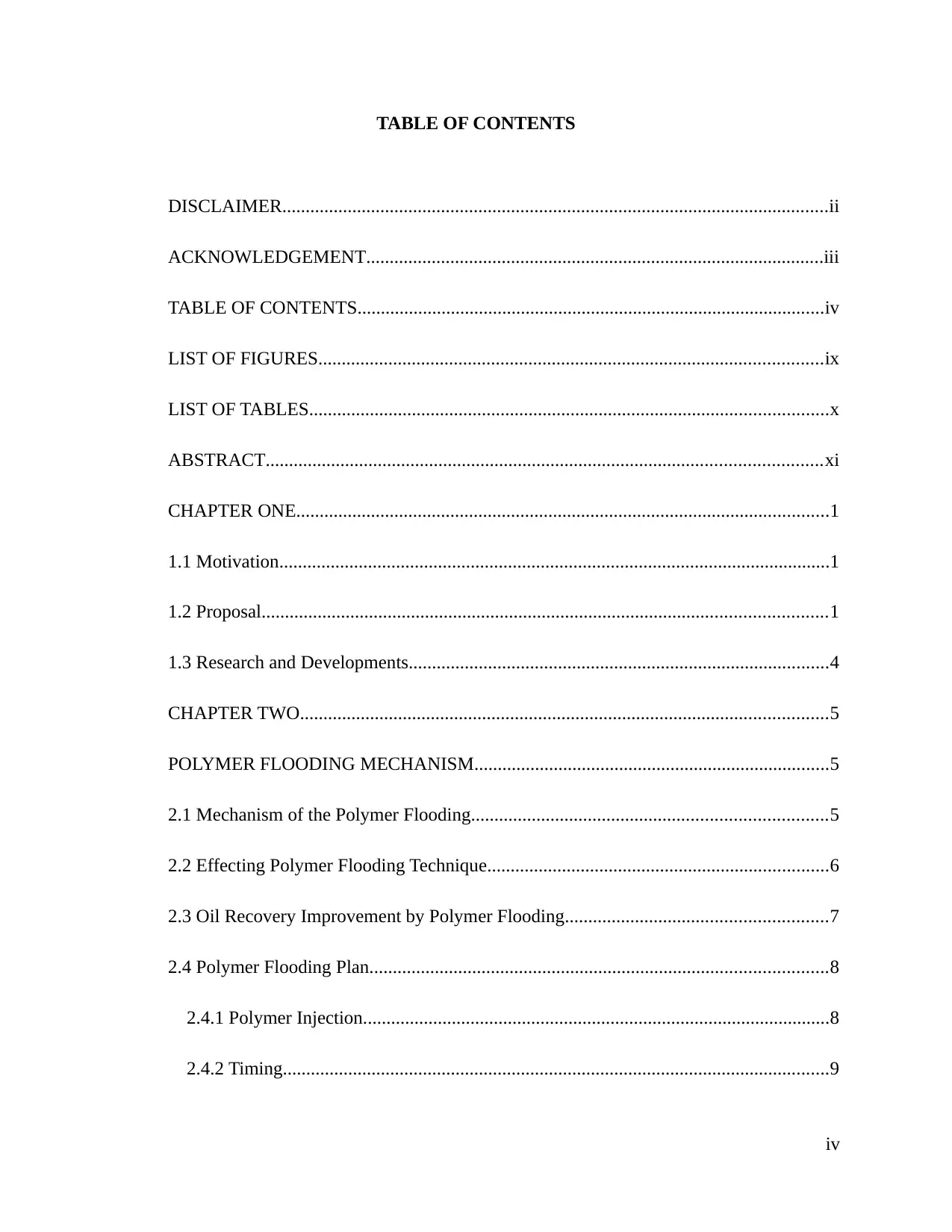
TABLE OF CONTENTS
DISCLAIMER.....................................................................................................................ii
ACKNOWLEDGEMENT..................................................................................................iii
TABLE OF CONTENTS....................................................................................................iv
LIST OF FIGURES............................................................................................................ix
LIST OF TABLES...............................................................................................................x
ABSTRACT.......................................................................................................................xi
CHAPTER ONE..................................................................................................................1
1.1 Motivation......................................................................................................................1
1.2 Proposal.........................................................................................................................1
1.3 Research and Developments..........................................................................................4
CHAPTER TWO.................................................................................................................5
POLYMER FLOODING MECHANISM............................................................................5
2.1 Mechanism of the Polymer Flooding............................................................................5
2.2 Effecting Polymer Flooding Technique.........................................................................6
2.3 Oil Recovery Improvement by Polymer Flooding........................................................7
2.4 Polymer Flooding Plan..................................................................................................8
2.4.1 Polymer Injection....................................................................................................8
2.4.2 Timing.....................................................................................................................9
iv
DISCLAIMER.....................................................................................................................ii
ACKNOWLEDGEMENT..................................................................................................iii
TABLE OF CONTENTS....................................................................................................iv
LIST OF FIGURES............................................................................................................ix
LIST OF TABLES...............................................................................................................x
ABSTRACT.......................................................................................................................xi
CHAPTER ONE..................................................................................................................1
1.1 Motivation......................................................................................................................1
1.2 Proposal.........................................................................................................................1
1.3 Research and Developments..........................................................................................4
CHAPTER TWO.................................................................................................................5
POLYMER FLOODING MECHANISM............................................................................5
2.1 Mechanism of the Polymer Flooding............................................................................5
2.2 Effecting Polymer Flooding Technique.........................................................................6
2.3 Oil Recovery Improvement by Polymer Flooding........................................................7
2.4 Polymer Flooding Plan..................................................................................................8
2.4.1 Polymer Injection....................................................................................................8
2.4.2 Timing.....................................................................................................................9
iv
Paraphrase This Document
Need a fresh take? Get an instant paraphrase of this document with our AI Paraphraser
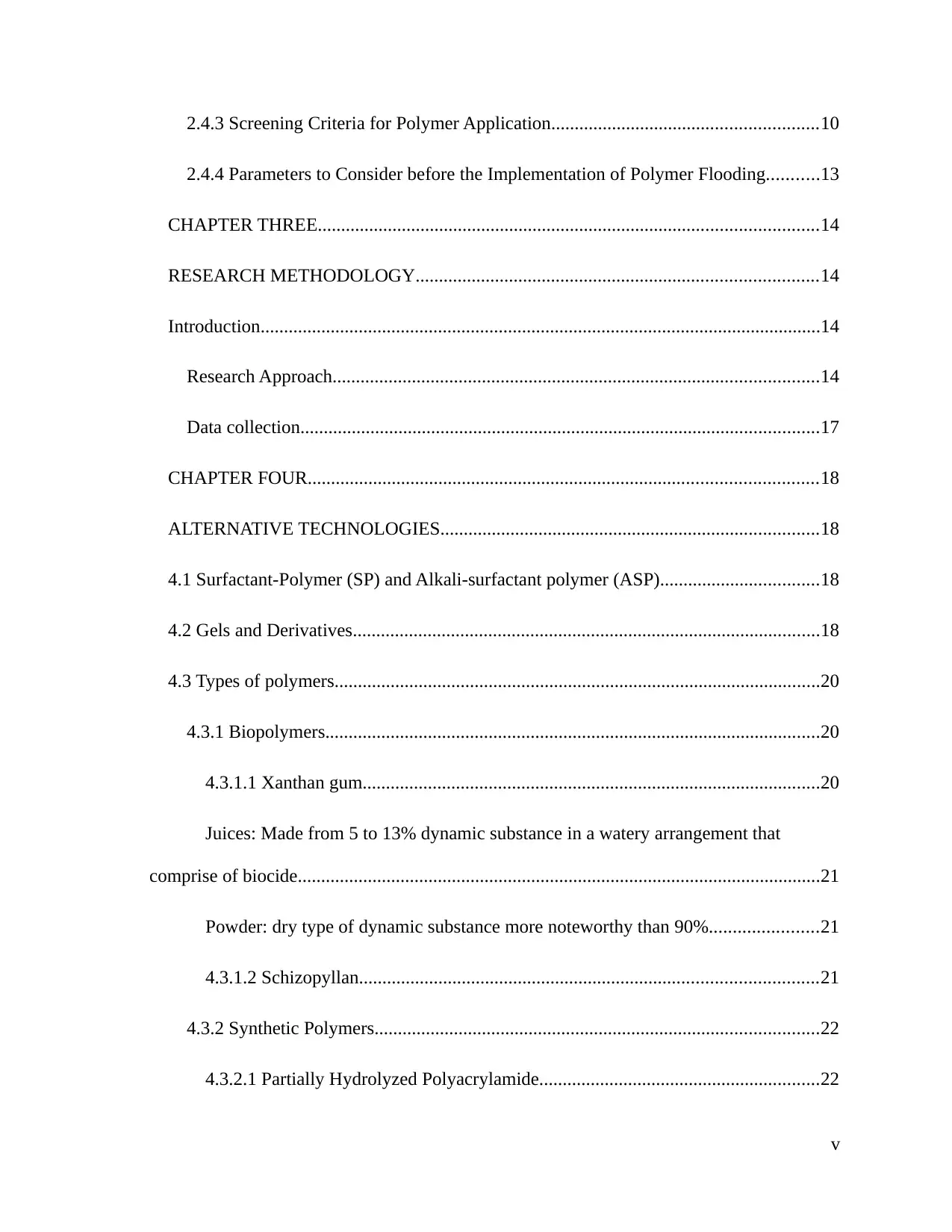
2.4.3 Screening Criteria for Polymer Application.........................................................10
2.4.4 Parameters to Consider before the Implementation of Polymer Flooding...........13
CHAPTER THREE...........................................................................................................14
RESEARCH METHODOLOGY......................................................................................14
Introduction........................................................................................................................14
Research Approach........................................................................................................14
Data collection...............................................................................................................17
CHAPTER FOUR.............................................................................................................18
ALTERNATIVE TECHNOLOGIES.................................................................................18
4.1 Surfactant-Polymer (SP) and Alkali-surfactant polymer (ASP)..................................18
4.2 Gels and Derivatives....................................................................................................18
4.3 Types of polymers........................................................................................................20
4.3.1 Biopolymers..........................................................................................................20
4.3.1.1 Xanthan gum..................................................................................................20
Juices: Made from 5 to 13% dynamic substance in a watery arrangement that
comprise of biocide................................................................................................................21
Powder: dry type of dynamic substance more noteworthy than 90%.......................21
4.3.1.2 Schizopyllan..................................................................................................21
4.3.2 Synthetic Polymers...............................................................................................22
4.3.2.1 Partially Hydrolyzed Polyacrylamide............................................................22
v
2.4.4 Parameters to Consider before the Implementation of Polymer Flooding...........13
CHAPTER THREE...........................................................................................................14
RESEARCH METHODOLOGY......................................................................................14
Introduction........................................................................................................................14
Research Approach........................................................................................................14
Data collection...............................................................................................................17
CHAPTER FOUR.............................................................................................................18
ALTERNATIVE TECHNOLOGIES.................................................................................18
4.1 Surfactant-Polymer (SP) and Alkali-surfactant polymer (ASP)..................................18
4.2 Gels and Derivatives....................................................................................................18
4.3 Types of polymers........................................................................................................20
4.3.1 Biopolymers..........................................................................................................20
4.3.1.1 Xanthan gum..................................................................................................20
Juices: Made from 5 to 13% dynamic substance in a watery arrangement that
comprise of biocide................................................................................................................21
Powder: dry type of dynamic substance more noteworthy than 90%.......................21
4.3.1.2 Schizopyllan..................................................................................................21
4.3.2 Synthetic Polymers...............................................................................................22
4.3.2.1 Partially Hydrolyzed Polyacrylamide............................................................22
v
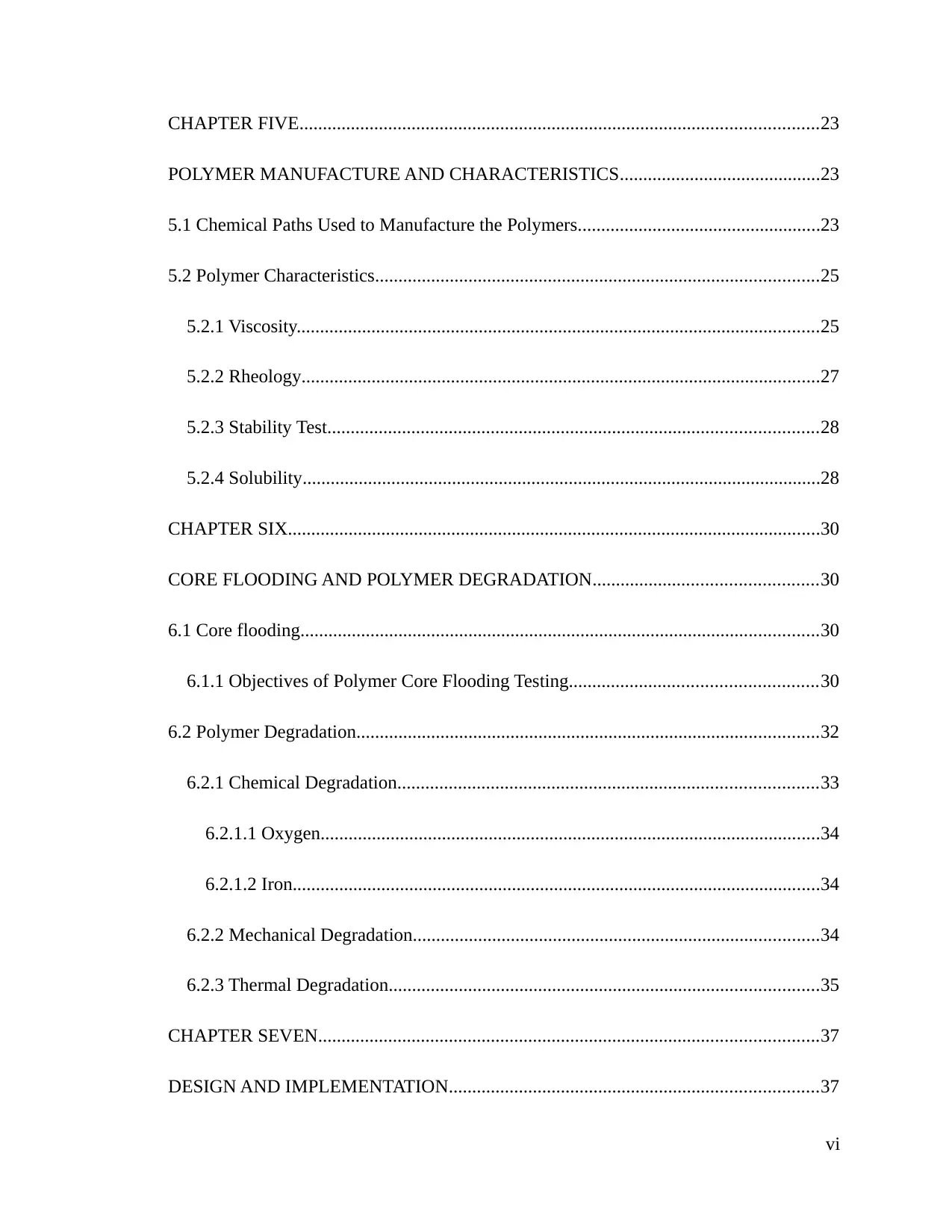
CHAPTER FIVE...............................................................................................................23
POLYMER MANUFACTURE AND CHARACTERISTICS...........................................23
5.1 Chemical Paths Used to Manufacture the Polymers....................................................23
5.2 Polymer Characteristics...............................................................................................25
5.2.1 Viscosity................................................................................................................25
5.2.2 Rheology...............................................................................................................27
5.2.3 Stability Test.........................................................................................................28
5.2.4 Solubility...............................................................................................................28
CHAPTER SIX..................................................................................................................30
CORE FLOODING AND POLYMER DEGRADATION................................................30
6.1 Core flooding...............................................................................................................30
6.1.1 Objectives of Polymer Core Flooding Testing.....................................................30
6.2 Polymer Degradation...................................................................................................32
6.2.1 Chemical Degradation..........................................................................................33
6.2.1.1 Oxygen...........................................................................................................34
6.2.1.2 Iron.................................................................................................................34
6.2.2 Mechanical Degradation.......................................................................................34
6.2.3 Thermal Degradation............................................................................................35
CHAPTER SEVEN...........................................................................................................37
DESIGN AND IMPLEMENTATION...............................................................................37
vi
POLYMER MANUFACTURE AND CHARACTERISTICS...........................................23
5.1 Chemical Paths Used to Manufacture the Polymers....................................................23
5.2 Polymer Characteristics...............................................................................................25
5.2.1 Viscosity................................................................................................................25
5.2.2 Rheology...............................................................................................................27
5.2.3 Stability Test.........................................................................................................28
5.2.4 Solubility...............................................................................................................28
CHAPTER SIX..................................................................................................................30
CORE FLOODING AND POLYMER DEGRADATION................................................30
6.1 Core flooding...............................................................................................................30
6.1.1 Objectives of Polymer Core Flooding Testing.....................................................30
6.2 Polymer Degradation...................................................................................................32
6.2.1 Chemical Degradation..........................................................................................33
6.2.1.1 Oxygen...........................................................................................................34
6.2.1.2 Iron.................................................................................................................34
6.2.2 Mechanical Degradation.......................................................................................34
6.2.3 Thermal Degradation............................................................................................35
CHAPTER SEVEN...........................................................................................................37
DESIGN AND IMPLEMENTATION...............................................................................37
vi
⊘ This is a preview!⊘
Do you want full access?
Subscribe today to unlock all pages.

Trusted by 1+ million students worldwide
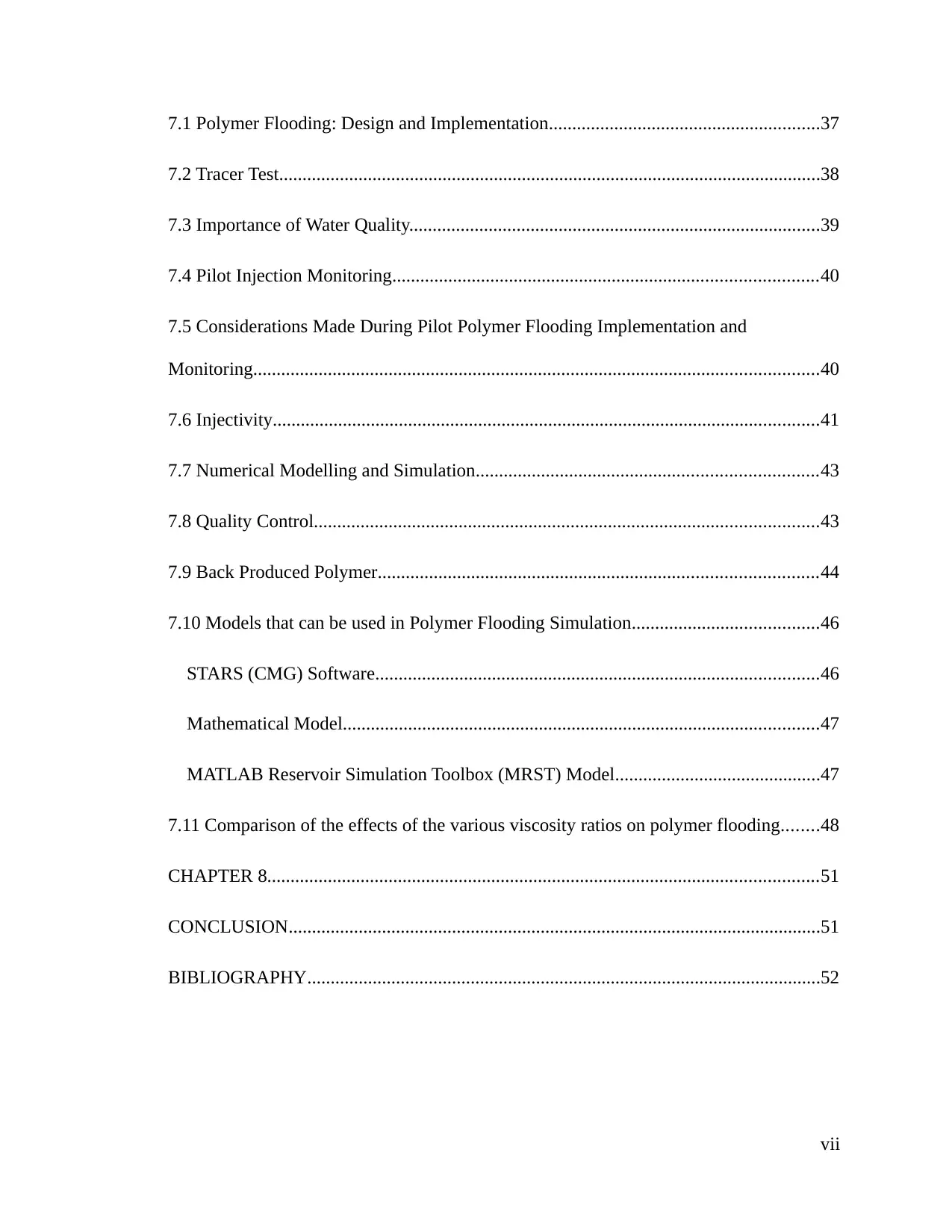
7.1 Polymer Flooding: Design and Implementation..........................................................37
7.2 Tracer Test....................................................................................................................38
7.3 Importance of Water Quality........................................................................................39
7.4 Pilot Injection Monitoring...........................................................................................40
7.5 Considerations Made During Pilot Polymer Flooding Implementation and
Monitoring.........................................................................................................................40
7.6 Injectivity.....................................................................................................................41
7.7 Numerical Modelling and Simulation.........................................................................43
7.8 Quality Control............................................................................................................43
7.9 Back Produced Polymer..............................................................................................44
7.10 Models that can be used in Polymer Flooding Simulation........................................46
STARS (CMG) Software...............................................................................................46
Mathematical Model......................................................................................................47
MATLAB Reservoir Simulation Toolbox (MRST) Model............................................47
7.11 Comparison of the effects of the various viscosity ratios on polymer flooding........48
CHAPTER 8......................................................................................................................51
CONCLUSION..................................................................................................................51
BIBLIOGRAPHY..............................................................................................................52
vii
7.2 Tracer Test....................................................................................................................38
7.3 Importance of Water Quality........................................................................................39
7.4 Pilot Injection Monitoring...........................................................................................40
7.5 Considerations Made During Pilot Polymer Flooding Implementation and
Monitoring.........................................................................................................................40
7.6 Injectivity.....................................................................................................................41
7.7 Numerical Modelling and Simulation.........................................................................43
7.8 Quality Control............................................................................................................43
7.9 Back Produced Polymer..............................................................................................44
7.10 Models that can be used in Polymer Flooding Simulation........................................46
STARS (CMG) Software...............................................................................................46
Mathematical Model......................................................................................................47
MATLAB Reservoir Simulation Toolbox (MRST) Model............................................47
7.11 Comparison of the effects of the various viscosity ratios on polymer flooding........48
CHAPTER 8......................................................................................................................51
CONCLUSION..................................................................................................................51
BIBLIOGRAPHY..............................................................................................................52
vii
Paraphrase This Document
Need a fresh take? Get an instant paraphrase of this document with our AI Paraphraser

viii

LIST OF FIGURES
Figure 1: Fingering effect prompted by the unfavorable mobility ratio .........................................3
Figure 2: Mechanism of polymer flooding technique.....................................................................6
Figure 3: Water breakthrough can be delayed and sweep efficiency...............................................7
Figure 4: Production profiles for water flood and polymer flood showing the economic limit......8
Figure 5: Comparison between polymer flood and gel systems....................................................16
Figure 6: Molecular structure of Xanthan gum.............................................................................17
Figure 7: Chemical Structure of glucan.........................................................................................18
Figure 8: Inverse emulsion system................................................................................................19
Figure 9: Overview of copolymerization process..........................................................................20
Figure 10: Overview of the post hydrolysis process.....................................................................21
Figure 11: Example of acrylamide and sodium acrylate copolymer..............................................22
Figure 12: Example of acrylamide. ATBS copolymer...................................................................22
Figure 13: Viscosity of several polymers as a function of concentration......................................23
Figure 14. Viscosity versus temperature for several polymers......................................................24
Figure 15: Types of fluids and their characteristics.......................................................................25
Figure 16: Viscosity profile for a non-typical non-Newtonian polyacrylamide fluid...................25
Figure 17: Typical glove box set-up to perform tests in anaerobic conditions..............................26
Figure 18: Mechanisms of polymer retention................................................................................30
Figure 19: Polymer degradation in presence of oxygen and iron 2 in 7.086g/L TDS brine..........31
Figure 20: Shear degradation and percentage of viscosity loss for polymers...............................33
Figure 21: Hydrolysis of acrylamide moieties along the polymer backbone................................34
Figure 22: Salt tolerance of different polymers.............................................................................34
Figure 23: Typical set-up used to perform filter ratio tests with vessel and graduated cylinders..43
Figure 24: Mechanical degradation of polymer solutions at different concentrations..................45
ix
Figure 1: Fingering effect prompted by the unfavorable mobility ratio .........................................3
Figure 2: Mechanism of polymer flooding technique.....................................................................6
Figure 3: Water breakthrough can be delayed and sweep efficiency...............................................7
Figure 4: Production profiles for water flood and polymer flood showing the economic limit......8
Figure 5: Comparison between polymer flood and gel systems....................................................16
Figure 6: Molecular structure of Xanthan gum.............................................................................17
Figure 7: Chemical Structure of glucan.........................................................................................18
Figure 8: Inverse emulsion system................................................................................................19
Figure 9: Overview of copolymerization process..........................................................................20
Figure 10: Overview of the post hydrolysis process.....................................................................21
Figure 11: Example of acrylamide and sodium acrylate copolymer..............................................22
Figure 12: Example of acrylamide. ATBS copolymer...................................................................22
Figure 13: Viscosity of several polymers as a function of concentration......................................23
Figure 14. Viscosity versus temperature for several polymers......................................................24
Figure 15: Types of fluids and their characteristics.......................................................................25
Figure 16: Viscosity profile for a non-typical non-Newtonian polyacrylamide fluid...................25
Figure 17: Typical glove box set-up to perform tests in anaerobic conditions..............................26
Figure 18: Mechanisms of polymer retention................................................................................30
Figure 19: Polymer degradation in presence of oxygen and iron 2 in 7.086g/L TDS brine..........31
Figure 20: Shear degradation and percentage of viscosity loss for polymers...............................33
Figure 21: Hydrolysis of acrylamide moieties along the polymer backbone................................34
Figure 22: Salt tolerance of different polymers.............................................................................34
Figure 23: Typical set-up used to perform filter ratio tests with vessel and graduated cylinders..43
Figure 24: Mechanical degradation of polymer solutions at different concentrations..................45
ix
⊘ This is a preview!⊘
Do you want full access?
Subscribe today to unlock all pages.

Trusted by 1+ million students worldwide
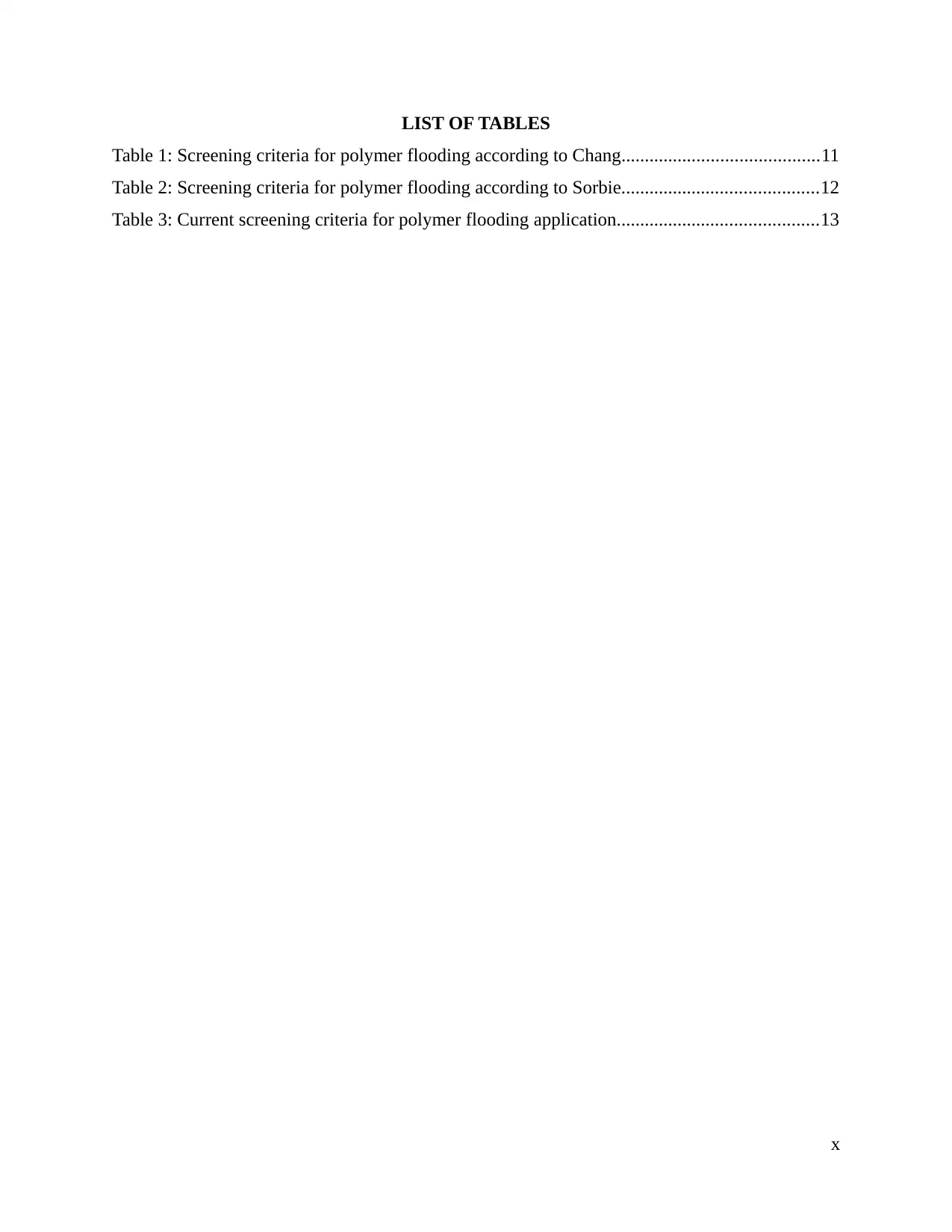
LIST OF TABLES
Table 1: Screening criteria for polymer flooding according to Chang..........................................11
Table 2: Screening criteria for polymer flooding according to Sorbie..........................................12
Table 3: Current screening criteria for polymer flooding application...........................................13
x
Table 1: Screening criteria for polymer flooding according to Chang..........................................11
Table 2: Screening criteria for polymer flooding according to Sorbie..........................................12
Table 3: Current screening criteria for polymer flooding application...........................................13
x
Paraphrase This Document
Need a fresh take? Get an instant paraphrase of this document with our AI Paraphraser
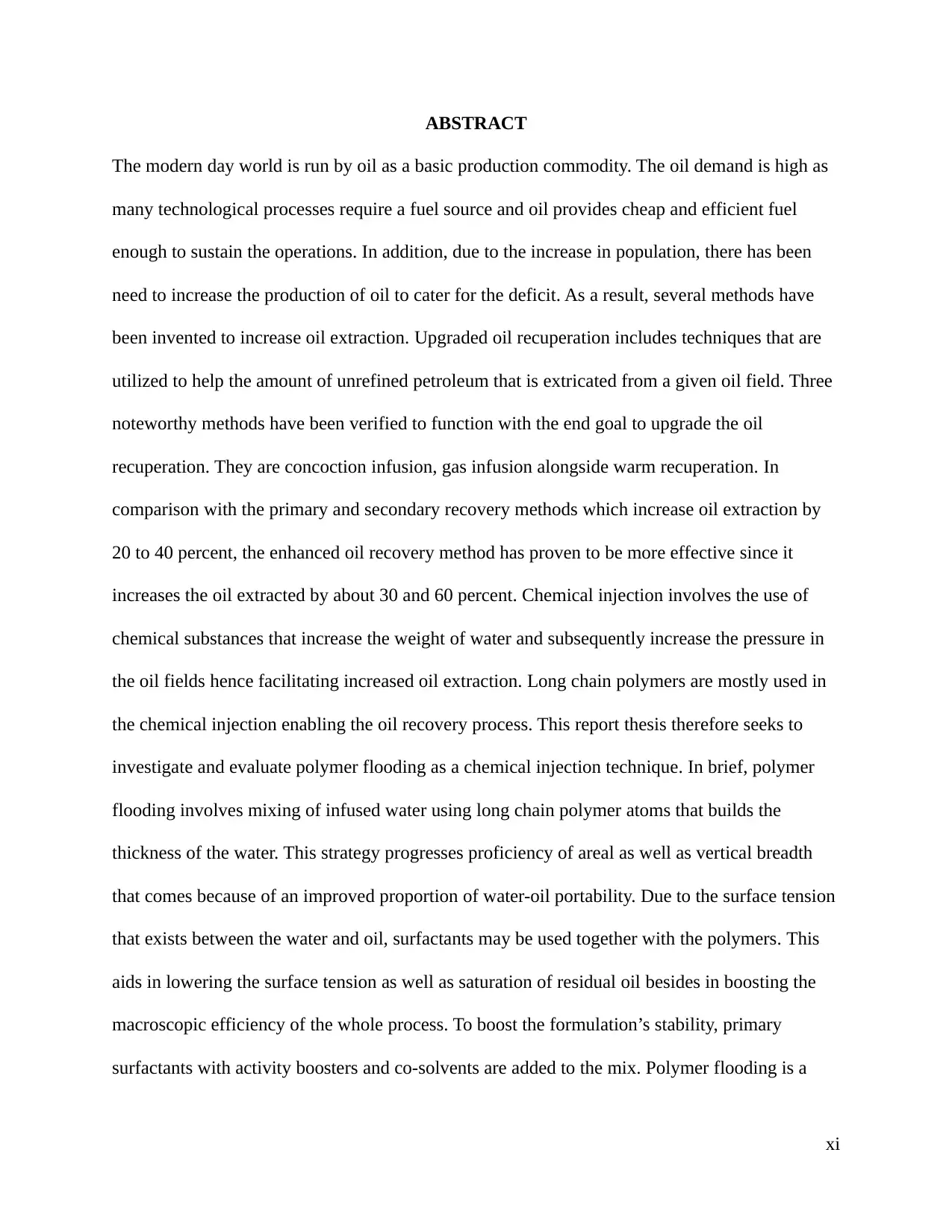
ABSTRACT
The modern day world is run by oil as a basic production commodity. The oil demand is high as
many technological processes require a fuel source and oil provides cheap and efficient fuel
enough to sustain the operations. In addition, due to the increase in population, there has been
need to increase the production of oil to cater for the deficit. As a result, several methods have
been invented to increase oil extraction. Upgraded oil recuperation includes techniques that are
utilized to help the amount of unrefined petroleum that is extricated from a given oil field. Three
noteworthy methods have been verified to function with the end goal to upgrade the oil
recuperation. They are concoction infusion, gas infusion alongside warm recuperation. In
comparison with the primary and secondary recovery methods which increase oil extraction by
20 to 40 percent, the enhanced oil recovery method has proven to be more effective since it
increases the oil extracted by about 30 and 60 percent. Chemical injection involves the use of
chemical substances that increase the weight of water and subsequently increase the pressure in
the oil fields hence facilitating increased oil extraction. Long chain polymers are mostly used in
the chemical injection enabling the oil recovery process. This report thesis therefore seeks to
investigate and evaluate polymer flooding as a chemical injection technique. In brief, polymer
flooding involves mixing of infused water using long chain polymer atoms that builds the
thickness of the water. This strategy progresses proficiency of areal as well as vertical breadth
that comes because of an improved proportion of water-oil portability. Due to the surface tension
that exists between the water and oil, surfactants may be used together with the polymers. This
aids in lowering the surface tension as well as saturation of residual oil besides in boosting the
macroscopic efficiency of the whole process. To boost the formulation’s stability, primary
surfactants with activity boosters and co-solvents are added to the mix. Polymer flooding is a
xi
The modern day world is run by oil as a basic production commodity. The oil demand is high as
many technological processes require a fuel source and oil provides cheap and efficient fuel
enough to sustain the operations. In addition, due to the increase in population, there has been
need to increase the production of oil to cater for the deficit. As a result, several methods have
been invented to increase oil extraction. Upgraded oil recuperation includes techniques that are
utilized to help the amount of unrefined petroleum that is extricated from a given oil field. Three
noteworthy methods have been verified to function with the end goal to upgrade the oil
recuperation. They are concoction infusion, gas infusion alongside warm recuperation. In
comparison with the primary and secondary recovery methods which increase oil extraction by
20 to 40 percent, the enhanced oil recovery method has proven to be more effective since it
increases the oil extracted by about 30 and 60 percent. Chemical injection involves the use of
chemical substances that increase the weight of water and subsequently increase the pressure in
the oil fields hence facilitating increased oil extraction. Long chain polymers are mostly used in
the chemical injection enabling the oil recovery process. This report thesis therefore seeks to
investigate and evaluate polymer flooding as a chemical injection technique. In brief, polymer
flooding involves mixing of infused water using long chain polymer atoms that builds the
thickness of the water. This strategy progresses proficiency of areal as well as vertical breadth
that comes because of an improved proportion of water-oil portability. Due to the surface tension
that exists between the water and oil, surfactants may be used together with the polymers. This
aids in lowering the surface tension as well as saturation of residual oil besides in boosting the
macroscopic efficiency of the whole process. To boost the formulation’s stability, primary
surfactants with activity boosters and co-solvents are added to the mix. Polymer flooding is a
xi
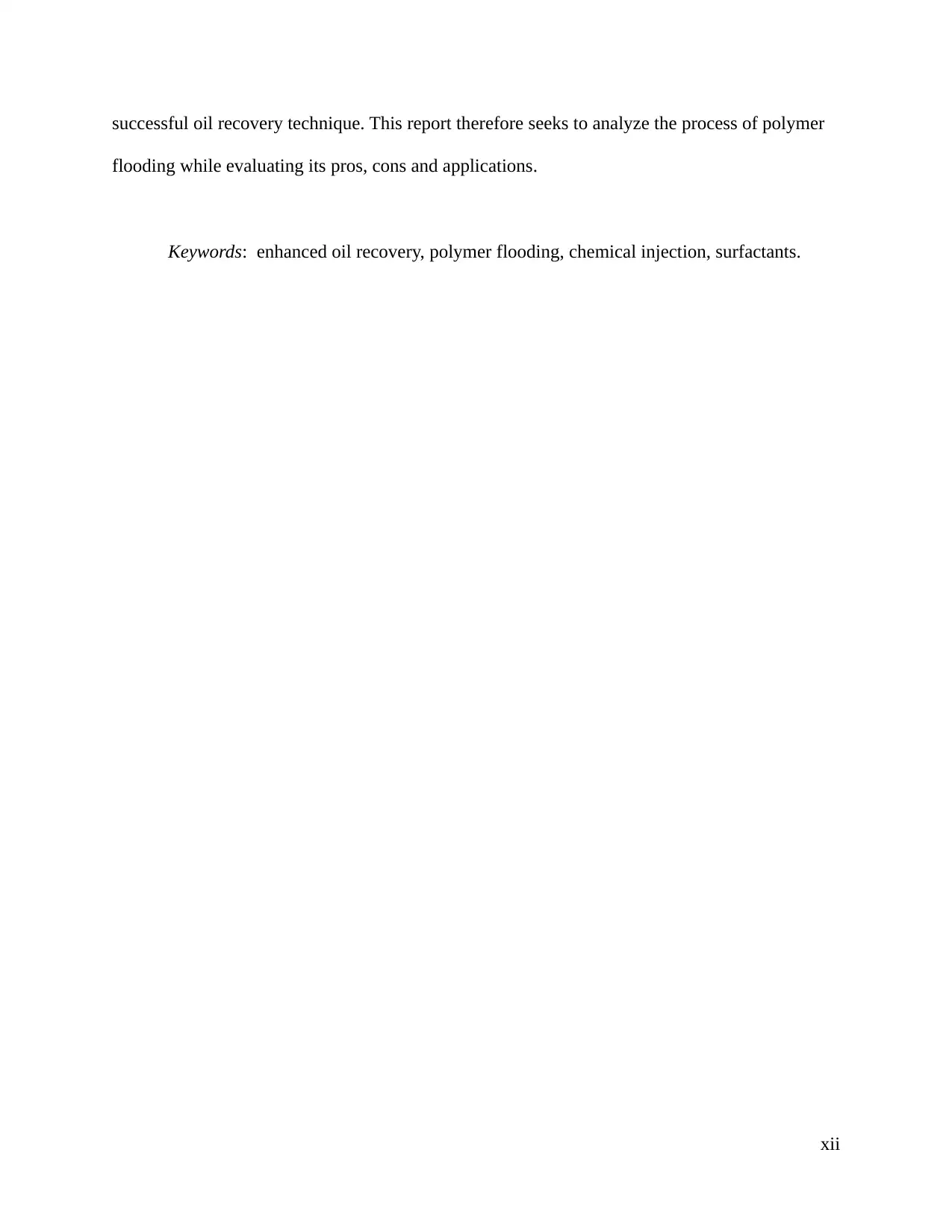
successful oil recovery technique. This report therefore seeks to analyze the process of polymer
flooding while evaluating its pros, cons and applications.
Keywords: enhanced oil recovery, polymer flooding, chemical injection, surfactants.
xii
flooding while evaluating its pros, cons and applications.
Keywords: enhanced oil recovery, polymer flooding, chemical injection, surfactants.
xii
⊘ This is a preview!⊘
Do you want full access?
Subscribe today to unlock all pages.

Trusted by 1+ million students worldwide
1 out of 68